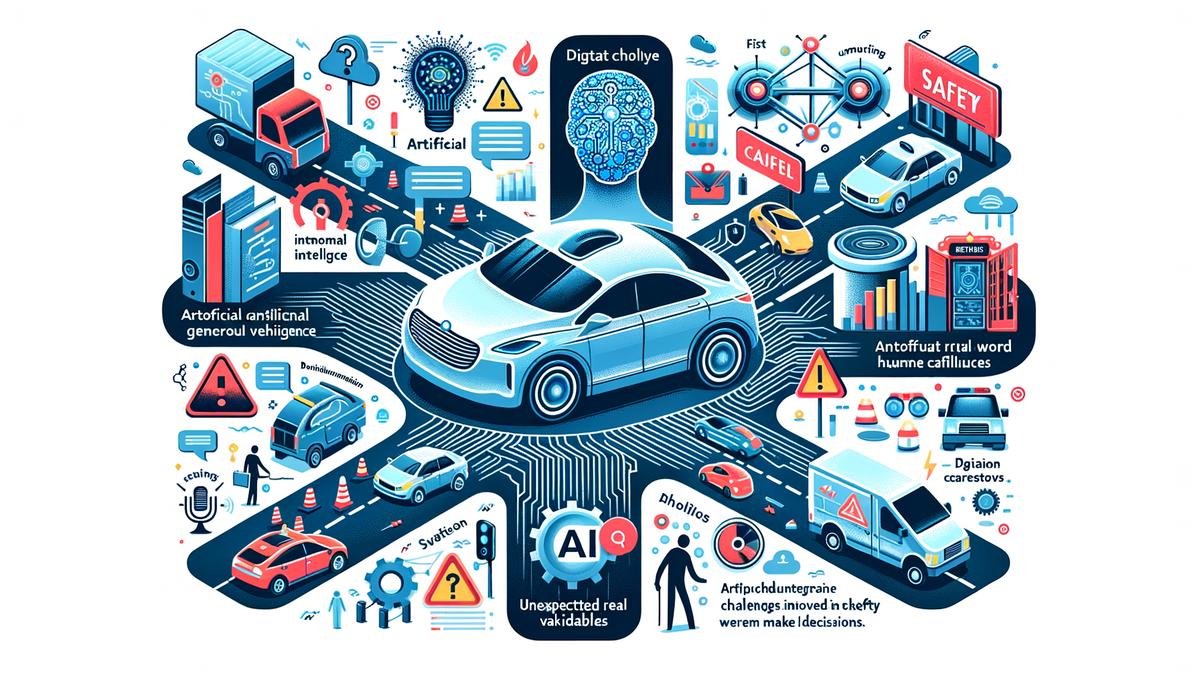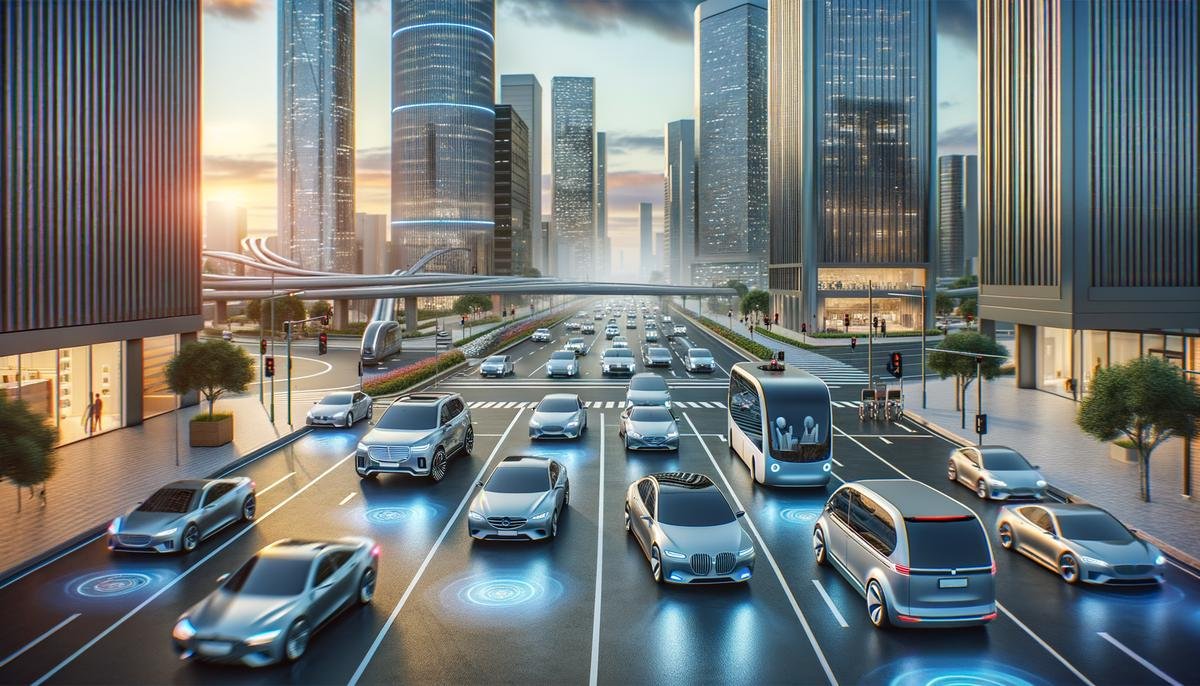Artificial General Intelligence (AGI) is transforming the landscape of autonomous vehicles, pushing towards a future where cars navigate the roads with an understanding and adaptability that closely mimics the human mind. This shift towards vehicles equipped with AGI promises a new era of transportation where decision-making, learning from experiences, and adapting to unforeseen circumstances become the cornerstone of autonomous driving. It’s a step beyond mere automation, towards vehicles that perceive, think, and make choices in ways that were once the realm of science fiction.
The Role of AGI in Autonomous Driving
Artificial General Intelligence (AGI) Revolutionizes Autonomous Vehicles
In the exciting world of technology, Artificial General Intelligence (AGI) is a game-changer for autonomous vehicles, steering them toward true autonomy. This fascinating leap taps into AGI’s capability to process and reason like the human mind. Unlike traditional systems, AGI enables cars to make decisions, adapt to unexpected situations, and learn from new experiences, setting the stage for a future where vehicles are not just self-driving but self-thinking.
At the heart of this transformation is AGI’s dynamic learning ability. Traditional autonomous systems rely on specific programmed responses, limiting their adaptability. AGI, however, learns from each encounter on the road, ensuring each decision is informed by a wealth of past experiences. This continuous learning process is akin to a human gaining driving experience over time, allowing the vehicle to navigate complex scenarios with ease.
AGI also introduces an unrivaled level of adaptability. It’s designed to handle the unpredictable nature of daily driving, from sudden weather changes to erratic behavior from other road users. This adaptability is crucial for autonomous vehicles to respond effectively in real-time, ensuring passenger safety and smooth operation in diverse conditions.
Furthermore, AGI’s advanced processing capabilities enable vehicles to understand and interact with their environment in a nuanced manner. This means cars can analyze and react to intricate road signs, pedestrians’ intentions, and even the subtle cues that indicate a cyclist’s next move. By processing this information comprehensively, AGI-equipped vehicles offer a safer, more reliable form of transportation that closely mirrors human driving intelligence.
Collaboration with existing technologies amplifies AGI’s impact. When paired with sensors, cameras, and radar systems, AGI’s processing power is unleashed, allowing for a detailed understanding of the vehicle’s surroundings. This symbiotic relationship between hardware and AGI software paves the way for vehicles that not only drive autonomously but also understand the world like a human driver.
Looking ahead, AGI’s role in autonomous vehicles hints at a future where cars could operate with minimal human intervention, even in complex urban environments. This could significantly reduce traffic accidents caused by human error, lower congestion, and provide mobility for those unable to drive.
In essence, AGI propels autonomous vehicles toward a future not just of automation but of true autonomy. By equipping cars with the ability to learn, adapt, and understand their environment on a human-like level, AGI blurs the line between human-driven and self-driving vehicles, offering a glimpse into the next revolutionary step in transportation.

Safety Challenges and Solutions
Building on the transformative potential of Artificial General Intelligence (AGI) in autonomous vehicles, key safety challenges emerge that necessitate careful consideration. As AGI propels vehicles toward true autonomy, ensuring the reliability and security of these intelligent systems is paramount.
One of the core safety challenges is the decision-making process of AGI. Unlike traditional systems, AGI can learn and make decisions based on vast data inputs. But how do we ensure these decisions are safe in every possible scenario on the road? Ensuring the AGI’s decision-making aligns with ethical and safe driving standards is a complex issue, involving not just technological advancements but also legal and societal norms.
Another critical safety challenge is cybersecurity. AGI systems, with their advanced connectivity and reliance on data, could be vulnerable to hacking and other cyber threats. A compromised vehicle doesn’t just risk the safety of its passengers but also poses a threat to others on the road. Developing robust cybersecurity measures is essential to protect these vehicles from external attacks.
Additionally, ensuring the reliability of AGI in various environmental conditions poses a significant challenge. AGI systems must perform reliably not just in ideal conditions but also in adverse weather, varying road qualities, and unpredictable real-world scenarios. This requires not only advanced sensory inputs and processing capabilities but also comprehensive testing to cover a broad spectrum of driving conditions.
Interoperability with other vehicles and infrastructure is another safety challenge. As AGI-driven vehicles share the roads with human drivers and other autonomous vehicles, ensuring seamless communication and interaction becomes critical. This includes not just real-time data exchange but also developing common standards and protocols that enable a smooth coexistence of diverse transportation systems.
Furthermore, addressing unexpected situations where AGI’s response is uncertain involves creating fail-safe mechanisms. These systems must be designed to recognize when they are out of their depth, possibly handing control back to a human driver or safely stopping the vehicle if human intervention is not possible.
Mitigating these safety challenges requires a concerted effort from manufacturers, policymakers, technologists, and society. It involves not just advancing the technology but also establishing rigorous testing standards, legal frameworks, and ethical guidelines. As AGI continues to evolve, focusing on these safety considerations will be crucial in realizing the full potential of autonomous vehicles while ensuring the safety and security of all road users.

Regulatory Frameworks and Ethical Considerations
Regulatory Frameworks and the Evolution of AGI in Autonomous Vehicles
The march toward fully autonomous vehicles powered by Artificial General Intelligence (AGI) is as exciting as it is fraught with regulatory challenges. As AGI technology evolves, so too does the necessity for comprehensive, robust regulatory frameworks to ensure that these advanced systems are deployed safely and ethically on public roads.
One of the core aspects shaping the deployment of AGI in self-driving cars is the establishment of rigorous testing and certification processes. Regulatory bodies worldwide are now tasked with developing new standards that can adequately assess an AGI system’s decision-making capabilities, adaptability, and reliability under diverse conditions. These processes are crucial, as they must confirm that AGI can navigate the complexities of real-world driving without compromising on safety.
Furthermore, data protection and privacy emerge as significant concerns. AGI systems rely on vast amounts of data, not just for navigational purposes, but also to learn and adapt. This raises questions about data ownership, usage rights, and protections, especially considering the potential for personal data to be collected and processed. Hence, regulations must address these concerns, ensuring that user data is handled securely and transparently.
Another dimension of regulatory frameworks focuses on accountability and liability in the event of an accident. Defining who—or what—is at fault in accidents involving AGI-powered autonomous vehicles poses a unique challenge for lawmakers. Is it the manufacturer, the software developer, or the AGI system itself? Navigating these legal nuances requires novel approaches to liability law, potentially reshaping the legal landscape as we know it.
Collaboration between regulatory authorities and industry stakeholders is key to developing standards that are both rigorous and flexible enough to accommodate future advancements in AGI technology. This collaborative approach ensures that regulations keep pace with technological innovations, fostering an environment where safety and progress go hand in hand.
Interoperability standards also play a critical role. As AGI systems become more prevalent, ensuring that these vehicles can communicate effectively with each other, as well as with traditional vehicles and transportation infrastructures, is paramount. Such standards are vital for preventing accidents, reducing congestion, and maximizing the benefits of autonomous vehicles to traffic management systems.
Looking ahead, the deployment of AGI in autonomous vehicles will significantly depend on how these regulatory challenges are addressed. It’s a complex dance between innovation and safety, data privacy, and public trust. As regulations evolve, they will not only shape the technology’s deployment but also influence public perception and acceptance of autonomous vehicles.
In essence, the journey toward AGI-powered autonomy is as much about navigating the legal and ethical frameworks as it is about technological advancements. As regulators, manufacturers, and technologists collaborate to forge these new paths, the horizon for AGI in autonomous vehicles expands, heralding a future where the potential of truly autonomous driving can be realized safely and effectively.

The Future of Autonomous Vehicles and AGI
As we venture into the horizon of autonomous vehicles powered by Artificial General Intelligence (AGI), several key factors will shape the future landscape. Among these, enhancing the passenger experience and environmental sustainability stand out as critical areas for development and innovation.
The integration of AGI in autonomous vehicles promises a revolution in the passenger experience. Imagine stepping into a car that not only knows your destination but also anticipates your needs during the journey. From adjusting the interior temperature to selecting your favorite music and finding the quickest route avoiding traffic, AGI’s predictive analytics and personalization capabilities could transform every journey into a tailored experience. The level of comfort and personalization would go beyond current expectations, offering a glimpse into a future where your car understands you almost as well as a human driver might.
Further enriching the passenger experience, AGI could enable seamless interaction between the vehicle and the passenger’s digital devices. This might involve syncing with calendars to suggest departure times based on scheduled appointments or integrating with smart home systems to ensure the house is secured upon departure. The possibilities for enhancing convenience and connectivity are vast, laying the groundwork for a future where vehicles are not just modes of transport but integral components of our digital lifestyles.
On the environmental front, the trajectory for autonomous vehicles powered by AGI is equally promising. These vehicles are expected to master eco-driving practices, optimizing routes and driving patterns to minimize fuel consumption or electric power usage, thereby reducing the vehicles’ carbon footprint. By leveraging real-time data on traffic conditions, weather, and road types, AGI could significantly enhance the efficiency of autonomous vehicles, contributing to a reduction in greenhouse gas emissions.
Moreover, the introduction of AGI into autonomous vehicle fleets could facilitate the optimization of shared mobility solutions. By intelligently coordinating vehicle dispatch and routing based on demand patterns, AGI can reduce the number of vehicles on the road, decreasing traffic congestion and further contributing to environmental benefits. This optimized coordination could extend to the integration of autonomous vehicles into broader public transportation networks, offering last-mile solutions that encourage the use of public transit and reduce reliance on private car ownership.
As for sustainable urban planning, AGI-powered autonomous vehicles could play a pivotal role in reshaping city landscapes. With less need for parking spaces, urban areas could be redesigned to provide more green spaces, pedestrian zones, and bicycle lanes, enhancing the quality of life in cities while promoting more sustainable forms of transport.
In sum, the horizon for autonomous vehicles guided by AGI is marked by immense potential to redefine our relationship with personal and shared transportation. Beyond the technological marvels and the promise of safer roads, the shift towards AGI-driven autonomy holds the power to drastically improve the passenger experience while steering us towards a more sustainable and environmentally friendly future. The journey towards this horizon will require continued innovation, collaboration across disciplines, and a commitment to navigating the complex ethical and societal considerations inherent in integrating AGI into our daily lives. As these autonomous systems evolve, our vision of the future of transportation broadens, pointing to a world where technology and human needs converge in harmony.

The march forward with Artificial General Intelligence within the realm of autonomous vehicles delineates a promising trajectory towards enhancing how we experience travel and interact with our environment. AGI stands at the precipice of forging a future rich in possibilities—ushering in vehicles that not only drive themselves but do so with an unprecedented level of intelligence, sensitivity, and environmental consciousness. As we progress, the seamless blend of technology with our daily lives paves the way for a transportation ecosystem that is not only safer and more efficient but also more in tune with the human experience and the world around us.




